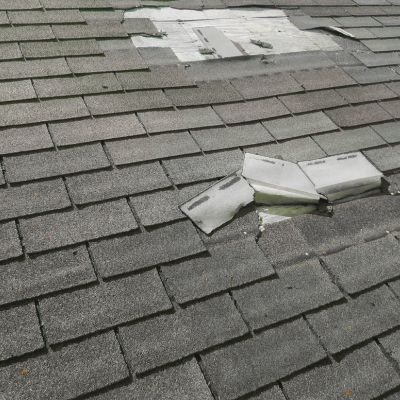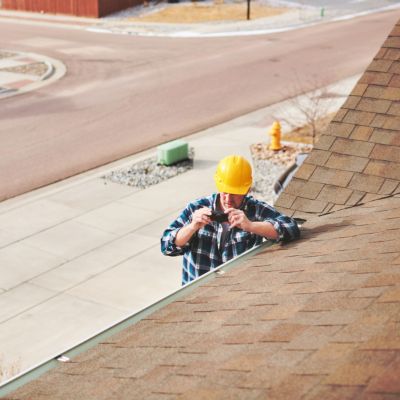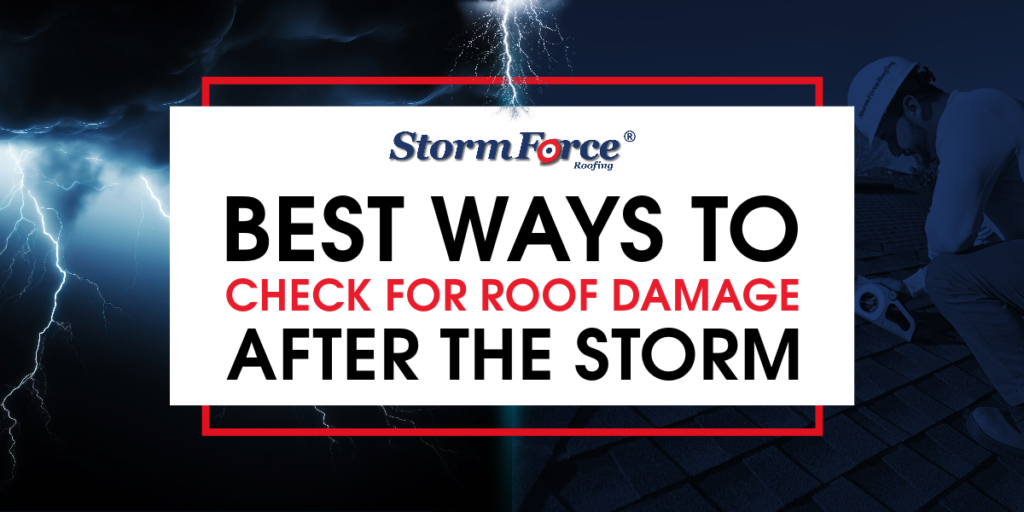In a moment, a storm can inflict significant or catastrophic destruction to your home, including the roof. However, not every weather outburst automatically produces devastation. As a homeowner, how can you know if a storm caused meaningful damage to your roof? Assuming your roof has sustained loss due to adverse weather, what immediate steps can you take to enact storm damage roof repair?
Common Signs A Roof Has Suffered Storm Damage

- Broken, cracked, dented, torn, or missing shingles or tiles
- Damage to gutters and downspouts (and even siding or windows)
- Excessive collecting of asphalt shingle granules in gutters or downspouts
- Roof, ceiling, and attic leaks or moisture intrusion (algae, mold, or mildew)
- Roofing debris and tree limbs/branches scattered around in the yard
- Unusually high utility bills – especially increases in heating or cooling costs
How To Self-Assess Roof Damage Following A Storm
As a homeowner, you must prioritize personal safety after a storm. Under no circumstances should you crawl on top of your roof. Most homeowners possess neither the right tools nor the proper equipment to access a roof securely without risking serious harm to themselves or their property. Each year, hundreds, if not thousands, of homeowners incur significant injury and, in some cases, death.
Once the storm has passed through your area, from ground level, observe signs of damage to your roof and property. Among other discoveries, you may find missing shingles, holes in your roof, or dents in your soffits or fascias. Photograph and video record your observations. Make detailed written notes of what you see. Try to leave evidence of dislodged roofing materials as-is for the time being.
If you can enter your attic safely and securely, inspect your attic for visible signs of damage to your roof, including, but not limited to, holes or other incursions caused by the storm. You may discover that water or moisture has infiltrated through your roofing system. Take note of any recent water stains or pooling. For purposes of tracking any damage, capture photographic and video evidence.
Assuming the storm included hail, look for signs of damage to your home and property. Although you may not distinguish whether or not your roof incurred hail damage, you could draw possible conclusions based on whether your siding, fascias, or gutters suffered the adverse effects of hail. If you identify irregular patterns of denting on any of these surfaces, your roof likely has a similar problem.
Involving A Qualified Professional To Identify Storm Damage To A Roof
Don’t take chances following a storm. Contact a knowledgeable and experienced roofing professional to facilitate a comprehensive analysis of your roofing system. A qualified roofing contractor with specialized expertise in identifying signs of storm damage will guide you through what to do next. If filing a claim with your insurance provider makes sense, the contractor can help you make that decision.
A trained roofing professional knows if and how a storm has caused damage to your roofing system. Commonly, they first will conduct a visual inspection at ground level. They will look for collateral damage around your property. If hail or wind has impacted your home or property, signs of excess wear (i.e., missing shingles, random dents in siding, doors, gutters, fascias, etc. ) will likely be readily apparent.

Following this initial step, the roofing contractor will advance to the roof to perform a visual inspection and utilize other tools, equipment, and technology to investigate further. For reputable professionals, this process requires identifying the root cause of the damage. Most qualified roofing companies can distinguish between hail, wind, hurricane, or other reasons the roof suffered particular forms of damage.
Throughout the inspection, an experienced roofing professional understands the importance of carefully documenting any observations and noting any evidence to support whether a storm caused damage and to what extent the roof suffered a loss due to a storm. They will take a meaningful volume of photographs and video recordings and prepare a detailed written report accurately describing their findings.
Storm Damage Roof Repair Explained
At some point following a storm, the time will come for roof repair. In the immediate aftermath of a storm, a roofing company may take mitigation measures to limit further damage to a home. Frequently, this process involves tarping the roof if significant holes or leaks appear. Once the extent of damage has been determined, a plan of action will come to fruition to guide the roofing contractor to the next step.
A roof needing repair demands that a qualified contractor perform the work. In most cases, an insurance claim is filed. The insurance company will require adherence to a particular process to ensure the roofer completes the repair work on time and within budget. An experienced contractor will capably maneuver through this stage by performing any repair work per the insurance company’s standards.
Selecting The Right Contractor To Check For Post-Storm Roof Damage
For residents of Florida, StormForce Roofing offers only the highest level of customer service, workmanship, and roofing materials. Our unyielding commitment to protecting your home transcends every aspect of your roof repair, restoration, or replacement project. Contact us today to learn more about how we can help you with any of your roofing needs or to schedule a free, no-obligation appointment.
